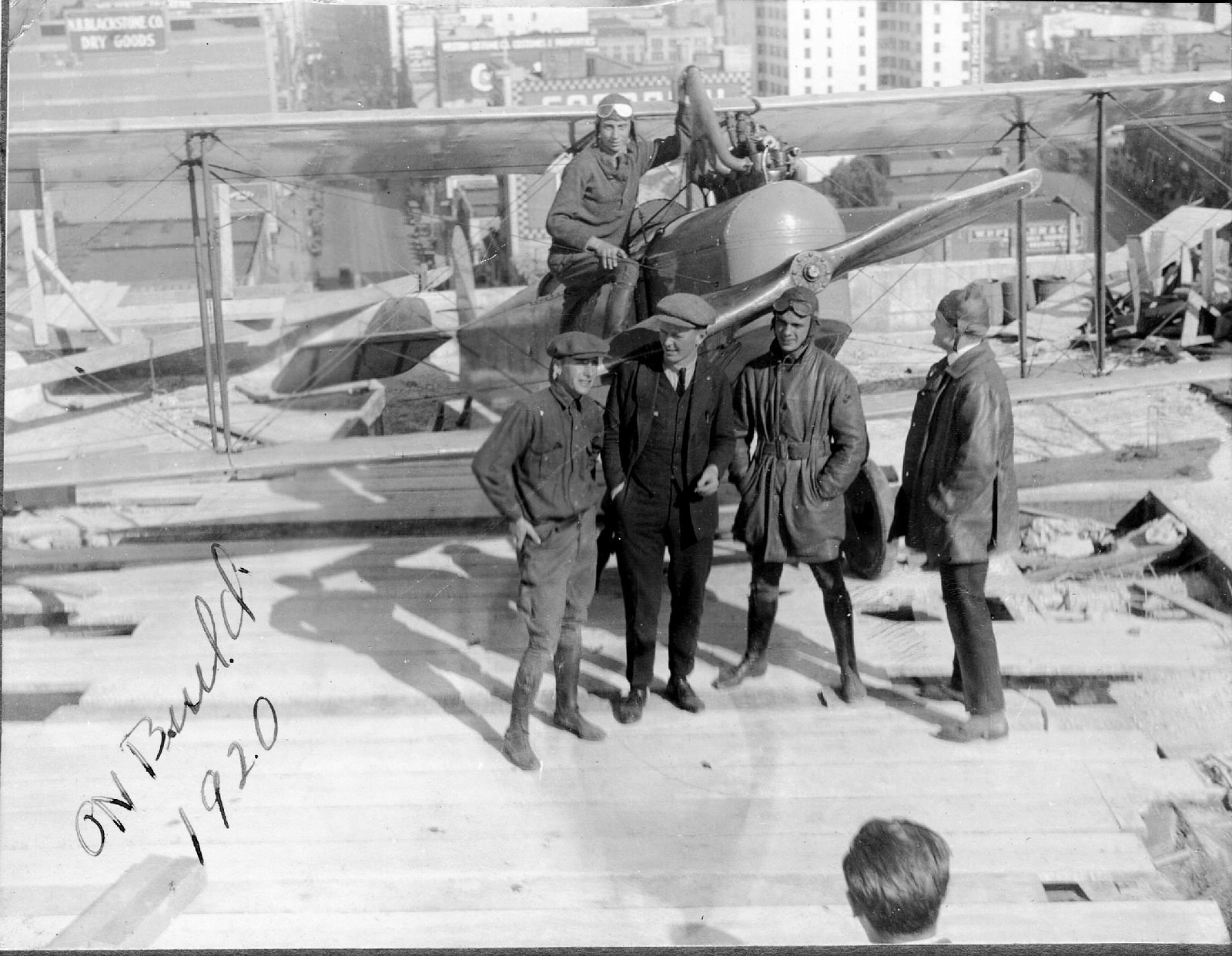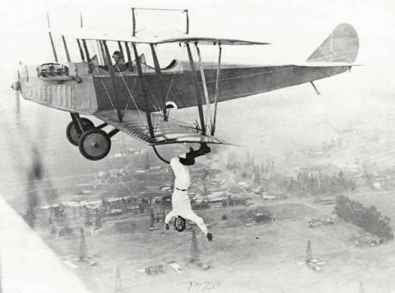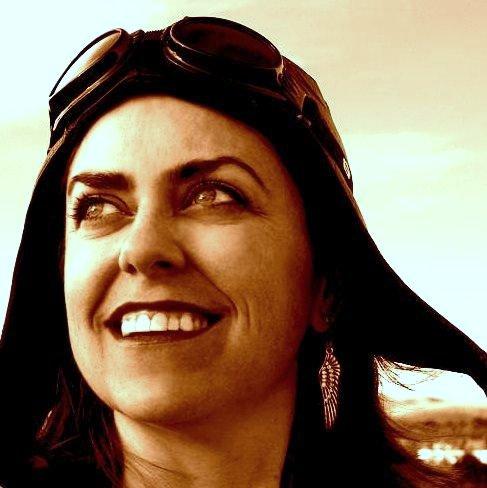"King of the Air" Frank Clarke Flys Airplane Off of L.A. Railway Building for Stranger Than Fiction Film
December 22, 2021
Trailblazing Stunt Pilot Was the Stuff Movies Are Made of
L.A. Times Staff Writer
Barnstorming pilots were the daredevil missionaries of aviation's pioneering era, and none of them did more for the cause than Los Angeles' Frank Clarke. He melded two of the world's, and the city's, most promising new technologies: flight and film.
In 1920, thousands of Angelenos watched transfixed as the "king of stunt pilots" took wing from the roof of the Railway Building in a Jenny biplane, whose parts he had smuggled up while the building was under construction.
Astonished pedestrians and commuters paused to watch as Clarke roared down a specially constructed 100-foot-long wooden ramp atop the 10-story building on the northeast corner of 11th Street and Broadway. Legions of Americans would share the experience; Clarke had it filmed as part of the popular silent movie "Stranger Than Fiction."
That was the beginning of a three-decade career in which Clarke became the prototypal Hollywood stunt pilot, transforming his youthful exploits into a glamorous staple of the film industry.
He performed many midair firsts for the cameras, continually plotting and executing new and imaginative stunts.
In one, he landed a plane on a moving train. In another, he changed planes in midair without a rope or ladder. For another scene, he left the cockpit, walked to the tail and sat down. From there, he flew the biplane by using a rope tied to the control stick in the cockpit--rather like pulling the reins of a horse in midair.
In another famous movie scene, he dressed in a cop's uniform, climbed from the cockpit and chased another stunt pilot dressed in convict's stripes across the craft's wings.
The tricks he invented were dangerous, and he insisted on trying them first, making sure they were safe before others attempted them.
Born on a ranch near Paso Robles, Calif., in 1898, Clarke was a 6-foot-2 cowpuncher who contracted aviation fever after watching barnstormers at the 1915 Fresno County Fair. Three years later, he headed for Los Angeles, where he learned to fly from legendary stunt pilots Al Wilson and Swede Meyerhofer at De Lay Field, near the mud flats of Venice. Meyerhofer would later be sliced in half by the propeller of a plane.
Clarke and Wilson organized the Wild West Flying Circus, which performed madcap aerial feats at the Venice Pier and across a nation enthralled by aviation. They never wore parachutes, considering them "for sissies."
One day, as Wilson attempted a plane change hanging by his knees, he lost his grip and fell. Clarke was flying close by with a cameraman aboard. Instantly, he put his plane into a dive and intercepted Wilson's tumbling body. Wilson plunged headfirst through the upper wing of Clarke's biplane--and stayed there, feet up and alive, as the plane landed safely.
It was one of the most spectacular midair catches in all of aviation history, according to author and historian Don Dwiggins in "The Air Devils." And Clarke's cameraman got it all on film.
Throughout his career, Clarke's passions remained Irish whiskey, pretty girls and the adrenaline rush that comes from cheating death. He made a name for himself with Hollywood scriptwriters, who began to rely on his expertise and recklessness. He was, in fact, the stuff movies are made of.
In 1927, Clarke's death-defying maneuvers in the Academy Award-winning silent film classic "Wings" earned him a job the following year with 22-year-old millionaire producer Howard Hughes

Filming began for their rousing World War I action-adventure, "Hell's Angels," at the San Fernando Valley airport called Caddo Field, after Hughes' production company. Together, Clarke and Hughes assembled the world's largest private air force. Hundreds of pilots, mechanics and ground crewmen were hired to operate an aerial armada of such legendary World War I fighter planes as Sikorskys, Sopwith Camels, Avros, Fokkers and a Thomas Morse Scout with its infamous Le Rhone rotary engine. Hughes crashed the latter when he took off after a heated argument with his leading man, Ben Lyon.
In several climactic scenes filmed over San Francisco Bay and the San Fernando Valley, Clarke--who was cast as the German flying ace Manfred Von Richthofen, a.k.a. the Red Baron--led a squadron of 40 stunt pilots in simulated dogfights.
But it came at a considerable human cost. Clarke took it as a personal blow when three pilots died during filming.
Clem "Little Phil" Phillips was the first to die, breaking his neck in a crash.
Al Johnson hit some power lines during a low-level maneuver; he crashed and was burned in the wreckage.
But what most horrified Clarke and the rest of the crew was the death of young mechanic Phil Jones.
One scene required the crash of a German bomber. Hughes offered Clarke $10,000 to pull it off, but the pilot refused, saying it was too dangerous. But Clarke's friend Wilson agreed to fly the plane and jump just before impact. Jones volunteered to lie in the fuselage releasing smoke to make it appear that the plane had been hit by enemy fire.
Just as Wilson put the plane into a dive at 7,500 feet and the cameras began to roll, he heard the wing spar snap. He shouted to Jones to jump, then he bailed out. But Jones didn't see or hear Wilson; he was still making smoke when the plane crashed into an orange grove near Terra Bella Street and Haddon Avenue.
Clarke himself managed to walk away from a few plane crashes during his film career, each time carrying his whiskey bottle. During the 1923 filming of "The Woman With Four Faces," he took off from the seaside bluffs in Santa Monica, looked back to wave goodbye to actress Betty Compson and crashed into a tree. He had smiled so long at the stunning blond that he failed to see it.
Disgusted with himself, he found another tree to sit under, lit a cigarette, took a nip from the bottle and watched the film crew frantically searching for his body.
When World War II began, Clarke enlisted in the Air Force. He rose to the rank of major while teaching his seat-of-the-pants skills to young pilots.

In the military or out of it, Clarke lived for gut-wrenching experiences and playing jokes on friends.
In 1928, during the filming of "Eagle of the Night," he took producer-cameraman Jerry Fairbanks for a sightseeing spin. Before Fairbanks climbed aboard, Clarke kiddingly told him that he sometimes got uncontrollable urges to jump out of the plane. Fairbanks laughed.
As the plane leveled off and Fairbanks began to relax and enjoy the scenery, Clarke ducked to the floor of the biplane's rear cockpit and began flying it with his hands on the control cables. Fairbanks was no pilot; when he looked back and saw the empty seat, he was terror-stricken. And angry. He refused to speak to Clarke for two years after that.
Years later, what started as another practical joke turned into tragedy.
On June 13, 1948, Clarke was flying his two-seat BT-13 Vultee Valiant to Kernville, Calif., with a pilot friend, Mark Owen. They were on their way to visit a retired flying buddy, Frank Tomick. Clarke decided it would be amusing to drop a bag of manure on Tomick's cabin.
Clarke pushed the throttle forward in what was to have been a dive-bombing run. Tomick watched in horror as the plane plunged straight down into the ground and exploded. The sack of fertilizer had jammed behind the control stick, locking it.
The propeller from Clarke's BT-13 is mounted in concrete in an area known as Dutch Flats, west of Lake Isabella in the Green Horn Mountains. Etched in the propeller are his name and Owen's.
Barnstorming pilots were the daredevil missionaries of aviation's pioneering era, and none of them did more for the cause than Los Angeles' Frank Clarke. He melded two of the world's, and the city's, most promising new technologies: flight and film.
In 1920, thousands of Angelenos watched transfixed as the "king of stunt pilots" took wing from the roof of the Railway Building in a Jenny biplane, whose parts he had smuggled up while the building was under construction.
Astonished pedestrians and commuters paused to watch as Clarke roared down a specially constructed 100-foot-long wooden ramp atop the 10-story building on the northeast corner of 11th Street and Broadway. Legions of Americans would share the experience; Clarke had it filmed as part of the popular silent movie "Stranger Than Fiction."
That was the beginning of a three-decade career in which Clarke became the prototypal Hollywood stunt pilot, transforming his youthful exploits into a glamorous staple of the film industry.
He performed many midair firsts for the cameras, continually plotting and executing new and imaginative stunts.
In one, he landed a plane on a moving train. In another, he changed planes in midair without a rope or ladder. For another scene, he left the cockpit, walked to the tail and sat down. From there, he flew the biplane by using a rope tied to the control stick in the cockpit--rather like pulling the reins of a horse in midair.
In another famous movie scene, he dressed in a cop's uniform, climbed from the cockpit and chased another stunt pilot dressed in convict's stripes across the craft's wings.
The tricks he invented were dangerous, and he insisted on trying them first, making sure they were safe before others attempted them.
Born on a ranch near Paso Robles, Calif., in 1898, Clarke was a 6-foot-2 cowpuncher who contracted aviation fever after watching barnstormers at the 1915 Fresno County Fair. Three years later, he headed for Los Angeles, where he learned to fly from legendary stunt pilots Al Wilson and Swede Meyerhofer at De Lay Field, near the mud flats of Venice. Meyerhofer would later be sliced in half by the propeller of a plane.
Clarke and Wilson organized the Wild West Flying Circus, which performed madcap aerial feats at the Venice Pier and across a nation enthralled by aviation. They never wore parachutes, considering them "for sissies."
One day, as Wilson attempted a plane change hanging by his knees, he lost his grip and fell. Clarke was flying close by with a cameraman aboard. Instantly, he put his plane into a dive and intercepted Wilson's tumbling body. Wilson plunged headfirst through the upper wing of Clarke's biplane--and stayed there, feet up and alive, as the plane landed safely.
It was one of the most spectacular midair catches in all of aviation history, according to author and historian Don Dwiggins in "The Air Devils." And Clarke's cameraman got it all on film.
Throughout his career, Clarke's passions remained Irish whiskey, pretty girls and the adrenaline rush that comes from cheating death. He made a name for himself with Hollywood scriptwriters, who began to rely on his expertise and recklessness. He was, in fact, the stuff movies are made of.
In 1927, Clarke's death-defying maneuvers in the Academy Award-winning silent film classic "Wings" earned him a job the following year with 22-year-old millionaire producer Howard Hughes
Filming began for their rousing World War I action-adventure, "Hell's Angels," at the San Fernando Valley airport called Caddo Field, after Hughes' production company. Together, Clarke and Hughes assembled the world's largest private air force. Hundreds of pilots, mechanics and ground crewmen were hired to operate an aerial armada of such legendary World War I fighter planes as Sikorskys, Sopwith Camels, Avros, Fokkers and a Thomas Morse Scout with its infamous Le Rhone rotary engine. Hughes crashed the latter when he took off after a heated argument with his leading man, Ben Lyon.
In several climactic scenes filmed over San Francisco Bay and the San Fernando Valley, Clarke--who was cast as the German flying ace Manfred Von Richthofen, a.k.a. the Red Baron--led a squadron of 40 stunt pilots in simulated dogfights.
But it came at a considerable human cost. Clarke took it as a personal blow when three pilots died during filming.
Clem "Little Phil" Phillips was the first to die, breaking his neck in a crash.
Al Johnson hit some power lines during a low-level maneuver; he crashed and was burned in the wreckage.
But what most horrified Clarke and the rest of the crew was the death of young mechanic Phil Jones.
One scene required the crash of a German bomber. Hughes offered Clarke $10,000 to pull it off, but the pilot refused, saying it was too dangerous. But Clarke's friend Wilson agreed to fly the plane and jump just before impact. Jones volunteered to lie in the fuselage releasing smoke to make it appear that the plane had been hit by enemy fire.
Just as Wilson put the plane into a dive at 7,500 feet and the cameras began to roll, he heard the wing spar snap. He shouted to Jones to jump, then he bailed out. But Jones didn't see or hear Wilson; he was still making smoke when the plane crashed into an orange grove near Terra Bella Street and Haddon Avenue.
Clarke himself managed to walk away from a few plane crashes during his film career, each time carrying his whiskey bottle. During the 1923 filming of "The Woman With Four Faces," he took off from the seaside bluffs in Santa Monica, looked back to wave goodbye to actress Betty Compson and crashed into a tree. He had smiled so long at the stunning blond that he failed to see it.
Disgusted with himself, he found another tree to sit under, lit a cigarette, took a nip from the bottle and watched the film crew frantically searching for his body.
When World War II began, Clarke enlisted in the Air Force. He rose to the rank of major while teaching his seat-of-the-pants skills to young pilots.
In the military or out of it, Clarke lived for gut-wrenching experiences and playing jokes on friends.
In 1928, during the filming of "Eagle of the Night," he took producer-cameraman Jerry Fairbanks for a sightseeing spin. Before Fairbanks climbed aboard, Clarke kiddingly told him that he sometimes got uncontrollable urges to jump out of the plane. Fairbanks laughed.
As the plane leveled off and Fairbanks began to relax and enjoy the scenery, Clarke ducked to the floor of the biplane's rear cockpit and began flying it with his hands on the control cables. Fairbanks was no pilot; when he looked back and saw the empty seat, he was terror-stricken. And angry. He refused to speak to Clarke for two years after that.
Years later, what started as another practical joke turned into tragedy.
On June 13, 1948, Clarke was flying his two-seat BT-13 Vultee Valiant to Kernville, Calif., with a pilot friend, Mark Owen. They were on their way to visit a retired flying buddy, Frank Tomick. Clarke decided it would be amusing to drop a bag of manure on Tomick's cabin.
Clarke pushed the throttle forward in what was to have been a dive-bombing run. Tomick watched in horror as the plane plunged straight down into the ground and exploded. The sack of fertilizer had jammed behind the control stick, locking it.
The propeller from Clarke's BT-13 is mounted in concrete in an area known as Dutch Flats, west of Lake Isabella in the Green Horn Mountains. Etched in the propeller are his name and Owen's.
Posted by Shawna Kelly (Archiving Editor). Posted In : Aviator Actor



 Shawna Kelly, whose aerial courage includes skydiving at 10,000 feet, was inspired to write by her medal award-winning writer relative, Bliss Carman. She is also the great granddaughter of Daredevil DeLay, innovator of several aerial firsts for motion pictures and one of the aviators who gave his life performing --for our brave inspiration.
Shawna Kelly, whose aerial courage includes skydiving at 10,000 feet, was inspired to write by her medal award-winning writer relative, Bliss Carman. She is also the great granddaughter of Daredevil DeLay, innovator of several aerial firsts for motion pictures and one of the aviators who gave his life performing --for our brave inspiration.
